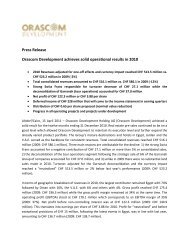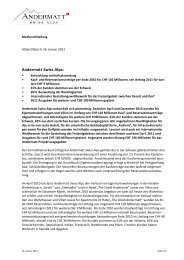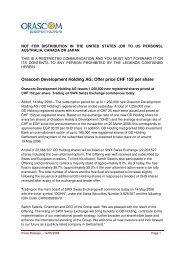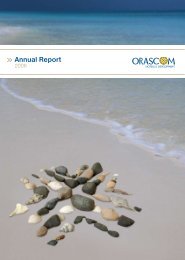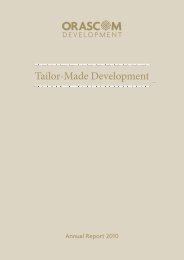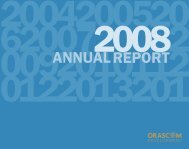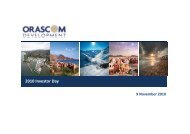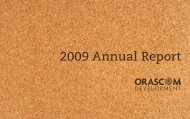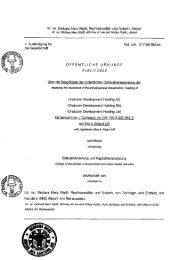FY 2012 Annual Report - Orascom Development
FY 2012 Annual Report - Orascom Development
FY 2012 Annual Report - Orascom Development
Create successful ePaper yourself
Turn your PDF publications into a flip-book with our unique Google optimized e-Paper software.
F-47 <strong>Orascom</strong> <strong>Development</strong> <strong>2012</strong> <strong>Annual</strong> <strong>Report</strong> F-48<br />
17 INVESTMENT PROPERTY<br />
The following table summarizes movements, which have occurred, during the current reporting period, on the carrying amount of<br />
investment property.<br />
CHF <strong>2012</strong> 2011<br />
FAIR VALUE OF COMPLETED INVESTMENT PROPERTY<br />
Balance at the beginning of the year 76,366,131 78,355,235<br />
Transfer from property, plant and equipment - 4,859,598<br />
Revaluation gain/(loss) 3,951,870 (4,745,050)<br />
Foreign currency translation adjustment (1,414,680) (2,103,652)<br />
Balance at the end of the year 78,903,321 76,366,131<br />
The Group’s investment properties are located in Mauritius and in Egypt.<br />
Their fair values at 31 December <strong>2012</strong> and 2011 have been arrived at on the basis of valuations carried out at these dates by Messrs<br />
Alan Tinkler, Ramlackhan & Co and Fincorp, independent valuation specialists not related to the Group. They are both accredited<br />
valuators in Mauritius and Egypt and have appropriate qualifications and recent experience in the valuation of properties in the<br />
relevant locations.<br />
Both valuation companies have relied on the Discounted Cash Flow (DCF) method to determine the fair value of the investment<br />
property. The Discounted Cash Flow (DCF) approach describes a method to value the investment property using the concepts of<br />
the time value of money. All future cash flows are estimated and discounted to give them a present value. This valuation method<br />
is in conformity with the International Valuation Standards.<br />
For the valuation of the major investment property (86% of total value) in Mauritius the valuer used cash flow projections based on<br />
the rental contracts and the financial budgets approved by the directors, covering a ten-year period and an average discount rate<br />
of 10.52% per annum for Mauritius. The expected rental income based on the rental contracts was indexed using a historical<br />
inflation index provided by Eurostat.<br />
For the valuation of the residual investment property situated in Egypt the valuer used cash flow projections based on financial<br />
budgets for the next four years and an average discount rate of 22.6% (cost of equity). For the terminal value a perpetual growth<br />
rate of 3% was used.<br />
All of the Group’s investment property is held under freehold interests. The following table summarizes income and direct<br />
operating expenses from investment properties rented out to third parties.<br />
CHF <strong>2012</strong> 2011<br />
Rental income from investment properties (i) 6,170,558 5,943,966<br />
Direct operating expenses (including repairs and maintenance) arising from<br />
investment properties that generated rental income during the period<br />
1,689,212 1,253,799<br />
18.1 Allocation of goodwill to cash-generating units<br />
<strong>Annual</strong> test for impairment<br />
An impairment test of goodwill was performed by the Group in order to assess the recoverable amount of its goodwill. No<br />
impairment was recorded as a result of this test. All cash-generating units were tested for impairment using the Discounted Cash<br />
Flow (DCF) method in accordance with IFRS.<br />
The Group’s business segments have been identified as cash–generating units. The DCF model utilized to evaluate the recoverable<br />
amounts of these units was based on a five year projection period. A further description of the assumptions used in the model is<br />
given in the following paragraphs.<br />
The carrying amount of goodwill that has been allocated for impairment testing purposes is as follows:<br />
CHF Segment <strong>2012</strong> 2011<br />
Hotel companies * Hotels 7,331,756 7,951,210<br />
*Each subsidiary considered separately<br />
7,331,756 7,951,210<br />
Hotels<br />
As already mentioned, Egypt has been on the brink of social and political turmoils in the past couple of years. While the Egyptian<br />
uprising has come with the promise of major political reform, it has led to the temporary disruption of economic activity. Looking<br />
beyond the current crisis, Egypt can benefit from maintaining its current momentum towards economic liberalization,<br />
privatization, and a more efficient government. This will improve Egypt’s economic position and help foster a sustained growth<br />
once the inevitable global economic upturn materializes. In light of the previously mentioned analysis, the impairment model has<br />
taken the current economical situation of Egypt into close consideration.<br />
The recoverable amount of each cash-generating unit has been determined based on a value in use calculation which uses cash<br />
flow projections based on the financial budgets approved by management covering a five-year period and an average discount<br />
rate of 18% per annum (2011: 19% per annum). The discount rate is based on a risk free tax rate of 10.5% as well as a risk premium<br />
of 7.5%. An average occupancy rate of 75% - 80% was used for the calculations.<br />
Cash flow projections during the budget period were based on management’s expected growth rates for each hotel within the<br />
cash-generating unit. The cash flows beyond that five year period were extrapolated using a growth rate between 0% and 3%.<br />
No impairment loss (2011: CHF nil) was recognized due to impairment test described above.<br />
Sensitivity analysis where the average discount rate was increased by 4.5% and the growth rate reduced by 0.5%, which according<br />
to management is a reasonably possible change in key assumptions, did not cause the aggregate carrying amount to exceed the<br />
aggregate recoverable amount of the cash-generating unit.<br />
Furthermore, management believes that any reasonably possible change in the key assumptions (sensitivity analysis) on which the<br />
recoverable amount is based would not cause the aggregate carrying amount to exceed the aggregate recoverable amount of the<br />
cash-generating unit.<br />
(i)<br />
See note 7.1 for further information on the Group’s rental income.<br />
18 GOODWILL<br />
CHF <strong>2012</strong> 2011<br />
Cost 7,331,756 7,951,210<br />
Accumulated impairment losses - -<br />
Carrying amount at end of year 7,331,756 7,951,210<br />
CHF <strong>2012</strong> 2011<br />
COST<br />
Balance at beginning of year 7,951,210 8,208,807<br />
Effect of foreign currency exchange differences (619,454) (257,597)<br />
Balance at end of year 7,331,756 7,951,210<br />
F-47<br />
F-48



